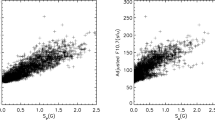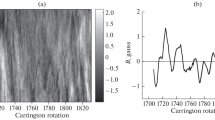Abstract
Magnetic flux cancellation on the Sun plays a crucial role in determining the way in which the net magnetic flux changes in every solar cycle, affecting the large scale evolution of the coronal magnetic field and heliospheric environment. We have investigated the correlation between the solar magnetic flux cancelled at the equator and the solar magnetic flux transported to the poles by comparing the net amount of magnetic flux in the latitude belt 0∘ – 5∘ to that of 45∘ – 60∘ and 55∘ – 90∘, using synoptic magnetograms from the National Solar Observatory at Kitt Peak, during Solar Cycles 21 – 24. We find a good correlation between the net flux in the latitude bands 0∘ – 5∘ and 55∘ – 90∘ when the net flux for the northern and southern hemispheres are considered together. In addition, we have investigated the correlation between the net flux cancelled at the equator during each cycle and the strength of solar polar field at each cycle minimum and we find a good correlation between the two. We discuss the implication of the correlation between the flux transported across the equator and to the poles, which has an important bearing in the estimation of the residual polar cap field strength at the cycle minimum. This can be used as a predictive tool for estimating the amplitude of subsequent cycles, and we use it to estimate a maximum smoothed sunspot number of 76 ± 5 and 85 ± 5 for the northern and southern hemispheres, respectively, for the upcoming Solar Cycle 25.








Similar content being viewed by others
References
Babcock, H.W.: 1961, The topology of the Sun’s magnetic field and the 22-year cycle. Astrophys. J.133, 572. DOI. ADS.
Bhowmik, P., Nandy, D.: 2018, Prediction of the strength and timing of sunspot Cycle 25 reveal decadal-scale space environmental conditions. Nat. Commun.9, 5209. DOI. ADS.
Bisoi, S.K., Janardhan, P., Chakrabarty, D., Ananthakrishnan, S., Divekar, A.: 2014, Changes in quasi-periodic variations of solar photospheric fields: precursor to the deep solar minimum in Cycle 23? Solar Phys.289, 41. DOI. ADS.
Charbonneau, P.: 2010, Dynamo models of the solar cycle. Living Rev. Solar Phys.7, 3. DOI. ADS.
Choudhuri, A.R., Chatterjee, P., Jiang, J.: 2007, Predicting Solar Cycle 24 with a solar dynamo model. Phys. Rev. Lett.98(13), 131103. DOI. ADS.
Clette, F., Lefèvre, L.: 2016, The new sunspot number: assembling all corrections. Solar Phys.291, 2629. DOI. ADS.
Cliver, E.W.: 2016, Comparison of new and old sunspot number time series. Solar Phys.291, 2891. DOI. ADS.
Gopalswamy, N., Mäkelä, P., Yashiro, S., Akiyama, S.: 2018, Long-term solar activity studies using microwave imaging observations and prediction for Cycle 25. J. Atmos. Solar-Terr. Phys.176, 26. DOI. ADS.
Hale, G.E., Ellerman, F., Nicholson, S.B., Joy, A.H.: 1919, Astrophys. J.49, 153.
Hathaway, D.H.: 2010, The solar cycle. Living Rev. Solar Phys.7(1), 1. DOI. ADS.
Iijima, H., Hotta, H., Imada, S., Kusano, K., Shiota, D.: 2017, Improvement of solar-cycle prediction: plateau of solar axial dipole moment. Astron. Astrophys.607, L2. DOI. ADS.
Ingale, M., Janardhan, P., Bisoi, S.K.: 2019, Beyond the mini-solar maximum of Solar Cycle 24: declining solar magnetic fields and the response of the terrestrial magnetosphere. J. Geophys. Res.124, 6363. DOI. ADS.
Janardhan, P., Bisoi, S.K., Gosain, S.: 2010, Solar polar fields during Cycles 21 – 23: correlation with meridional flows. Solar Phys.267, 267. DOI. ADS.
Janardhan, P., Bisoi, S.K., Ananthakrishnan, S., Tokumaru, M., Fujiki, K., Jose, L., Sridharan, R.: 2015a, A 20 year decline in solar photospheric magnetic fields: inner-heliospheric signatures and possible implications. J. Geophys. Res.120, 5306. DOI. ADS.
Janardhan, P., Bisoi, S.K., Ananthakrishnan, S., Sridharan, R., Jose, L.: 2015b, Solar and interplanetary signatures of a Maunder-like grand solar minimum around the corner - implications to near-Earth space. Sun Geosph.10, 147. ADS.
Janardhan, P., Fujiki, K., Ingale, M., Bisoi, S.K., Rout, D.: 2018, Solar Cycle 24: an unusual polar field reversal. Astron. Astrophys.618, A148. DOI. ADS.
Jiang, J., Cameron, R.H., Schüssler, M.: 2015, The cause of the weak Solar Cycle 24. Astrophys. J. Lett.808, L28. DOI. ADS.
Jiang, J., Wang, J.-X., Jiao, Q.-R., Cao, J.-B.: 2018, Predictability of the solar cycle over one cycle. Astrophys. J.863, 159. DOI. ADS.
Leighton, R.B.: 1969, A magneto-kinematic model of the solar cycle. Astrophys. J.156, 1. DOI. ADS.
Mackay, D.H., Yeates, A.R.: 2012, The Sun’s global photospheric and coronal magnetic fields: observations and models. Living Rev. Solar Phys.9, 6. DOI. ADS.
Muñoz-Jaramillo, A., Balmaceda, L.A., DeLuca, E.E.: 2013, Using the dipolar and quadrupolar moments to improve solar-cycle predictions based on the polar magnetic fields. Phys. Rev. Lett.111(4), 041106. DOI. ADS.
Parker, E.N.: 1955a, Hydromagnetic dynamo models. Astrophys. J.122, 293. DOI. ADS.
Parker, E.N.: 1955b, The formation of sunspots from the solar toroidal field. Astrophys. J.121, 491. DOI. ADS.
Pulkkinen, T.: 2007, Space weather: terrestrial perspective. Living Rev. Solar Phys.4(1), 1. DOI. ADS.
Sasikumar Raja, K., Janardhan, P., Bisoi, S.K., Ingale, M., Subramanian, P., Fujiki, K., Maksimovic, M.: 2019, Global solar magnetic field and interplanetary scintillations during the past four solar cycles. Solar Phys.294, 123. DOI. ADS.
Schatten, K.: 2005, Fair space weather for Solar Cycle 24. Geophys. Res. Lett.32, 21106. DOI. ADS.
Schatten, K.H., Pesnell, W.D.: 1993, An early solar dynamo prediction: Cycle 23 is approximately Cycle 22. Geophys. Res. Lett.20, 2275. DOI. ADS.
Schatten, K.H., Scherrer, P.H., Svalgaard, L., Wilcox, J.M.: 1978, Using dynamo theory to predict the sunspot number during Solar Cycle 21. Geophys. Res. Lett.5, 411. DOI. ADS.
Schwenn, R.: 2006a, Solar wind sources and their variations over the solar cycle. Space Sci. Rev.124(1-4), 51. DOI. ADS.
Schwenn, R.: 2006b, Space weather: the solar perspective. Living Rev. Solar Phys.3(1), 2. DOI. ADS.
Sheeley, N.R. Jr.: 2005, Surface evolution of the Sun’s magnetic field: a historical review of the flux-transport mechanism. Living Rev. Solar Phys.2, 5. DOI. ADS.
Sofia, S., Fox, P., Schatten, K.: 1998, Forecast update for activity Cycle 23 from a dynamo-based method. Geophys. Res. Lett.25, 4149. DOI. ADS.
Svalgaard, L., Cliver, E.W., Kamide, Y.: 2005, Sunspot Cycle 24: smallest cycle in 100 years? Geophys. Res. Lett.32, 1104. DOI. ADS.
Upton, L.A., Hathaway, D.H.: 2018, An updated Solar Cycle 25 prediction with AFT: the modern minimum. Geophys. Res. Lett.45, 8091. DOI. ADS.
Wang, Y.-M., Nash, A.G., Sheeley, N.R. Jr.: 1989, Evolution of the sun’s polar fields during Sunspot Cycle 21 - poleward surges and long-term behavior. Astrophys. J.347, 529. DOI. ADS.
Wang, Y.-M., Robbrecht, E., Sheeley, N.R. Jr.: 2009, On the weakening of the polar magnetic fields during Solar Cycle 23. Astrophys. J.707, 1372. DOI. ADS.
Acknowledgements
The authors would like to thank the free use data policy of the National Solar Observatory (NSO/KP and NSO/SOLIS) and the Wilcox Solar Observatory (WSO) for the synoptic magnetogram data and World Data Center SILSO at the Royal Observatory of Belgium, Brussels, for the sunspot data. The SOLIS data obtained by the NSO Integrated Synoptic Program (NISP), managed by the NSO, which is operated by the Association of Universities for Research in Astronomy (AURA) Inc. under a cooperative agreement with the National Science Foundation. We thank the reviewer for his comments that help to improve the paper significantly. SKB acknowledges Dr. Dibyendu Nandi from the Indian Institute of Scientific and Educational Research (IISER), Kolkata, for the scientific discussion and the support where a lot of this study was carried out. SKB also acknowledges the support by the National Natural Science Foundation of China (NSFC) (NSFC grants No. 11750110422, 11433006, 11790301, and 11790305).
Author information
Authors and Affiliations
Corresponding author
Ethics declarations
Disclosure of Potential Conflicts of Interest
The authors declare that they have no conflicts of interest.
Additional information
Publisher’s Note
Springer Nature remains neutral with regard to jurisdictional claims in published maps and institutional affiliations.
Rights and permissions
About this article
Cite this article
Bisoi, S.K., Janardhan, P. A New Tool for Predicting the Solar Cycle: Correlation Between Flux Transport at the Equator and the Poles. Sol Phys 295, 79 (2020). https://doi.org/10.1007/s11207-020-01645-9
Received:
Accepted:
Published:
DOI: https://doi.org/10.1007/s11207-020-01645-9




